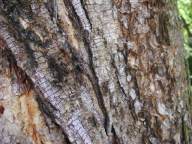Senegalia galpinii
Senegalia galpinii (Burtt Davy) Seigler & Ebinger
Family: Fabaceae
Common names: monkey-thorn (Eng.), Tshikwalo (Tshivenda), apiesdoring (Afr.), Molopa (North Sotho)
SA Tree No: 166
Introduction
This is a large tree with luxuriant, light green foliage, making it ideal for a big garden, avenue or park. It is also valued by farmers. This tree was previously called Acacia galpinii.

Description
Description
Senegalia galpinii is a deciduous tree, losing its leaves during the southern African winter (April-July). It is fast-growing and can reach 25-30 m. Creamy to light yellow flowers appear during the growing season (September-October). Reddish to purplish brown pods ripen during February-March. Senegalia galpinii is often confused with Senegalia polyacantha from which it can be distinguished by the gland on the leaf stalk: small in S. galpinii and large in S. polyacantha.

Distribution and habitat
Distribution description
Monkey-thorn grows naturally in open, wooded grassland, open woodland and often near streams. It is indigenous to Zambia, Zimbabwe, Malawi, northern and eastern Botswana and South Africa. In South Africa, Senegalia galpinii occurs naturally in Limpopo [Northern Province] and the North-West. It is seen as an indicator of sweet veld, which retains its nutritional value in winter.
Derivation of name and historical aspects
History
The previous genus name Acacia was is derived from the Greek word 'akis', meaning a point or a spike, referring to the thorns in many Acacia species. The South African species are armed with spines. Most of introduced species from Australia are spineless. The species was named in honour of Ernest Galpin (1854-1941), a plant collector. Monkeys like taking cover in its wide branches and may also eat the pods and seeds, hence the common name.
There are about 1 340 species in this genus of which 954 are indigenous to Australia, 230 to the Americas, 129 to Africa and some species scattered in Asia. This very large, pan-tropical genus occurs mainly in dry country.
Ecology
Ecology
Many insects such as bees and wasps visit the flowers. Ripe fruit pods burst open, releasing the seeds. Seeds are also dispersed by animals eating the pods.

Senegalia galpinii is one of the trees that can survive hot and dry conditions. It makes a stunning tree along roads where there is enough space. It is an ideal tree for a big garden. In the wild the plant is grazed and used for shade during the hot summer by different animals including giraffe, kudu and elephant. Many birds often prefer nesting in this tree as it provides protection. It provides dappled shade on hot summer days, making it an ideal tree for planting on a lawn where some sun can penetrate.
Growing Senegalia galpinii
Grow
Monkey-thorn is easy to propagate from seed that is not parasitized. Like other plants belonging to the Fabaceae, seed of this tree must be soaked in hot water overnight and then sown the next day. Seed must be sown in a seedling tray filled with river sand. To avoid unnecessary moisture loss, the seed can be covered with vermiculite. Seedlings are fairly fast-growing but must be protected from frost probably for the first growing season. Although it is frost-tolerant, severe frost often kills off tender young branches. The tree prefers full sun. Do not plant it too close to buildings as it has extensive roots.
References
- TIMBERLAKE, J., FAGG, C. & BARNES, R. 1998. Field guide to the acacias of Zimbabwe. CBC Publishing, Zimbabwe.
- VAN WYK, B. & VAN WYK, P. 1997. Field guide to trees of southern Africa. Struik, Cape Town.
- VENTER, F. & VENTER, J-A. 1996. Making the most of indigenous trees. Briza Publications, Pretoria.
- COATES PALGRAVE, K. 2002. Trees of southern Africa. Struik Publishers, Cape Town.
Credits
Thompson Mutshinyalo
Pretoria National Botanical Garden
January 2003
Plant Attributes:
Plant Type: Tree
SA Distribution: Gauteng, Limpopo, Mpumalanga, North West
Soil type: Sandy
Flowering season: Spring
PH: Neutral
Flower colour: Cream, Yellow
Aspect: Full Sun
Gardening skill: Easy
Special Features:
Horticultural zones









Rate this article
Article well written and informative
Rate this plant
Is this an interesting plant?
Login to add your Comment
Back to topNot registered yet? Click here to register.